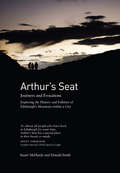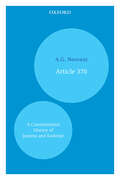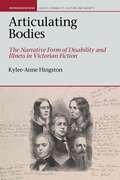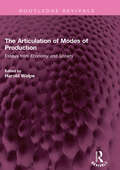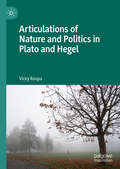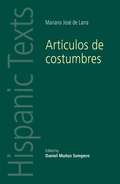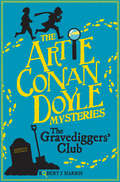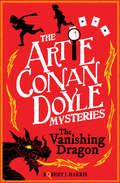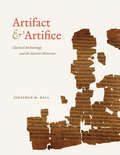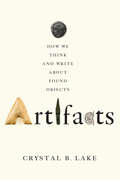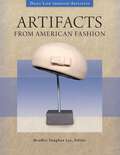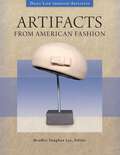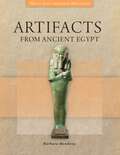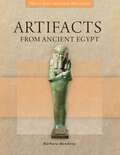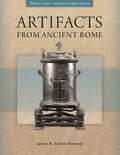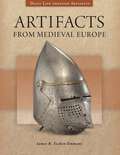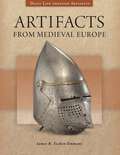- Table View
- List View
Arthur's Seat: Journeys and Evocations (Journeys And Evocations Ser. #1)
by Stuart McHardyArthur's Seat is climbed (or walked up and around) by thousands of people each year. The views from the top of the 350-million year old landmark are breathtaking. In this book, Stuart McHardy and Donald Smith interweave the tales of folklore and customs that surround this iconic hill. Review Draws on folklore tales and real life stories to create a unique walkers' guide to the famous ridges, crags and valleys that make up the hill. EDINBURGH EVENING NEWS Back Cover: Standing in the Hunter's Bog with the Salisbury Crags to the west, Dasses to the east and the great summit crag rising above, you could be deep in the Highlands. There is no sight and very little sound of the modern cityscape all around. STUART McHARDY Arthur's Seat, rising high above the Edinburgh skyline, is the city's most awe-inspiring landmark Although thousands climb to the summit every year, its history remains a mystery, shrouded in myth and legend. Quickly and suddenly we lose the sense of ciy. Through the park is now surrounded by Edinburgh, it still retains a sense of wildness. DONALD SMITH The first book of its kind, Arthur's Seat: Journeys and Evocations is a salute to the ancient tradition of storytelling, guiding the reader around Edinburgh's famous 'Resting Giant' with an exploration of the local folklore and customs associated with the mountain-within-a-city. Inspired by NVA's Speed of Light, a major event in Edinburgh's International Festival and the country-wide Cultural Olympiad, Journeys and Evocations brings together past and future in a perspective of the Edinburgh landscape like no other. A place where time does not pass but simply adds up. ROBERT GARIOCH
Article 370: A Constitutional History of Jammu and Kashmir
by A.G. NooraniOn 26 January 1950, the Constitution of India came into force with a unique provision—Article 370. The special status accorded to the state of Jammu and Kashmir in the article meant that its people lived under a different set of laws while being part of the Indian Union. Alternating deftly between history and politics, A.G. Noorani examines a wide range of documents pertaining to Article 370. He incisively analyses the implications and consequences of the article for the constitutional democracy of the state and the nation. From Jammu and Kashmir's accession to India in 1947 to the various negotiations thereafter; Sheikh Abdullah's arrest to the framing of the Constitution of Jammu and Kashmir and the replacement of Sadar-i-Riyasat, this book impeccably documents the little-known constitutional history of the state. Noorani underscores the politics behind the gradual erosion of Article 370 and the need for restoration of autonomy. Critically analysing the various judgments relating to this constitutional arrangement, he suggests a framework for resolving the 'Kashmir problem'. Collecting together rare, often unseen and unnoticed, letters, memoranda, white papers, proclamations, and amendments, this book will be an indispensable resource on Kashmir.
Articulating Bodies: The Narrative Form of Disability and Illness in Victorian Fiction (Representations: Health, Disability, Culture and Society #8)
by Kylee-Anne HingstonAn Open Access edition of this book is available on the Liverpool University Press website and through Knowledge Unlatched.Articulating Bodies investigates the contemporaneous developments of Victorian fiction and disability’s medicalization by focusing on the intersection between narrative form and body. The book examines texts from across the century, from Frederic Shoberl’s 1833 English translation of Victor Hugo’s Notre-Dame de Paris to Arthur Conan Doyle’s Sherlock Holmes story “The Adventure of the Crooked Man” (1893), covering genres that typically relied upon disabled or diseased characters. By tracing the patterns of focalization and narrative structure across six decades of the nineteenth century and across six genres, Articulating Bodies demonstrates that throughout the Victorian era, authors of fiction used narrative form as well as narrative theme to negotiate how to categorize bodies, both constructing and questioning the boundary dividing normalcy from abnormality. As fiction’s form developed from the massive hybrid novels of the early decades of the nineteenth century to the case-study length of fin-de-siècle mysteries, disability became increasingly medicalized, moving from the position of spectacle to specimen.
The Articulation of Modes of Production: Essays from Economy and Society (Routledge Revivals)
by Harold WolpeFirst published in 1980, The Articulation of Modes of Production is primarily concerned with the concept of articulation of modes of production and with the analysis of a number of different social formations utilizing this concept. The emphasis is on the relationship between capitalist and other modes of production and on accounts of specific social formations which demonstrate the analytical power of the concept, but at the same time reveal a number of as yet unresolved problems. The introduction to the collection takes these problems at its starting point, and through a discussion of the theoretical literature, provides the basis for a more rigorous and complete analysis of social formations. This book will be of interest to students of economics, social policy, and history.
The Articulation of Modes of Production: Essays from Economy and Society (Routledge Revivals)
First published in 1980, The Articulation of Modes of Production is primarily concerned with the concept of articulation of modes of production and with the analysis of a number of different social formations utilizing this concept. The emphasis is on the relationship between capitalist and other modes of production and on accounts of specific social formations which demonstrate the analytical power of the concept, but at the same time reveal a number of as yet unresolved problems. The introduction to the collection takes these problems at its starting point, and through a discussion of the theoretical literature, provides the basis for a more rigorous and complete analysis of social formations. This book will be of interest to students of economics, social policy, and history.
Articulations of Nature and Politics in Plato and Hegel
by Vicky RoupaThis book examines nature as a foundational concept for political and constitutional theory, drawing on readings from Plato and Hegel to counter the view that optimal political arrangements are determined by nature. Focussing on the dialectical implications of the word ‘nature’, i.e. how it encompasses a range of meanings stretching up to the opposites of sensuousness and ideality, the book explores the various junctures at which nature and politics interlock in the philosophies of Plato and Hegel. Appearance and essence, inner life and public realm, the psychical and the political are all shown to be parts of a conflictual structure that requires both infinite proximity and irreducible distance. The book offers innovative interpretations of a number of key texts by Plato and Hegel to highlight the metaphysical and political implications of nature’s dialectical structure, and re-appraises their thinking of nature in a way that both respects and goes beyond their intentions.
Artículos de costumbres: by Mariano José de Larra (Hispanic Texts)
by Daniel Muñoz SempereA collection of satirical articles by the influential nineteenth-century Spanish journalist Mariano José de Larra.
Artículos de costumbres: by Mariano José de Larra (Hispanic Texts)
by Daniel Muñoz SempereA collection of satirical articles by the influential nineteenth-century Spanish journalist Mariano José de Larra.
Artie Conan Doyle and the Gravediggers' Club (The Artie Conan Doyle Mysteries #1)
by Robert J. HarrisOne day Arthur Conan Doyle will create the greatest detective of all -- Sherlock Holmes. But right now Artie Conan Doyle is a twelve-year-old Edinburgh schoolboy with a mystery of his own to solve. While sneaking out to explore Greyfriars Kirkyard by night, Artie and his best friend Ham spot a ghostly lady in grey and discover the footprints of a gigantic hound. Could the two mysteries be connected? These strange clues lead them to a series of robberies carried out the sinister Gravediggers' Club and soon they find themselves pitted against the villainous Colonel Braxton Dash. Will Artie survive his encounters with graveyards and ghosts in the foggy streets of nineteenth century Edinburgh -- or will his first case be his last? Robert J. Harris, author of The World Goes Loki series and William Shakespeare and the Pirate's Fire, brings the young Conan Doyle to life in this ingenious detective story full of twists, turns and shocking reveals.
Artie Conan Doyle and the Vanishing Dragon (The Artie Conan Doyle Mysteries #2)
by Robert J. HarrisOne day Arthur Conan Doyle will create the greatest detective of all -- Sherlock Holmes. But right now Artie Conan Doyle is a twelve-year-old Edinburgh schoolboy with a mystery of his own to solve. Artie and his friend Ham are hired to investigate a series of suspicious accidents that have befallen world-famous magician, the Great Wizard of the North. It seems someone is determined to sabotage his spectacular new illusion. When the huge mechanical dragon created for the show vanishes, the theft appears to be completely impossible. Artie must reveal the trick and unmask the villain or face the deadly consequences. The cards have been dealt, the spell has been cast, and the game is afoot once more! Robert J. Harris, author of The World's Gone Loki series and Will Shakespeare and the Pirate's Fire, brings the young Conan Doyle to life in the second book of this ingenious new detective series.
Artifact and Artifice: Classical Archaeology and the Ancient Historian
by Jonathan M. HallIs it possible to trace the footprints of the historical Sokrates in Athens? Was there really an individual named Romulus, and if so, when did he found Rome? Is the tomb beneath the high altar of St. Peter’s Basilica home to the apostle Peter? To answer these questions, we need both dirt and words—that is, archaeology and history. Bringing the two fields into conversation, Artifact and Artifice offers an exciting excursion into the relationship between ancient history and archaeology and reveals the possibilities and limitations of using archaeological evidence in writing about the past. Jonathan M. Hall employs a series of well-known cases to investigate how historians may ignore or minimize material evidence that contributes to our knowledge of antiquity unless it correlates with information gleaned from texts. Dismantling the myth that archaeological evidence cannot impart information on its own, he illuminates the methodological and political principles at stake in using such evidence and describes how the disciplines of history and classical archaeology may be enlisted to work together. He also provides a brief sketch of how the discipline of classical archaeology evolved and considers its present and future role in historical approaches to antiquity. Written in clear prose and packed with maps, photos, and drawings, Artifact and Artifice will be an essential book for undergraduates in the humanities.
Artifact and Artifice: Classical Archaeology and the Ancient Historian
by Jonathan M. HallIs it possible to trace the footprints of the historical Sokrates in Athens? Was there really an individual named Romulus, and if so, when did he found Rome? Is the tomb beneath the high altar of St. Peter’s Basilica home to the apostle Peter? To answer these questions, we need both dirt and words—that is, archaeology and history. Bringing the two fields into conversation, Artifact and Artifice offers an exciting excursion into the relationship between ancient history and archaeology and reveals the possibilities and limitations of using archaeological evidence in writing about the past. Jonathan M. Hall employs a series of well-known cases to investigate how historians may ignore or minimize material evidence that contributes to our knowledge of antiquity unless it correlates with information gleaned from texts. Dismantling the myth that archaeological evidence cannot impart information on its own, he illuminates the methodological and political principles at stake in using such evidence and describes how the disciplines of history and classical archaeology may be enlisted to work together. He also provides a brief sketch of how the discipline of classical archaeology evolved and considers its present and future role in historical approaches to antiquity. Written in clear prose and packed with maps, photos, and drawings, Artifact and Artifice will be an essential book for undergraduates in the humanities.
Artifact and Artifice: Classical Archaeology and the Ancient Historian
by Jonathan M. HallIs it possible to trace the footprints of the historical Sokrates in Athens? Was there really an individual named Romulus, and if so, when did he found Rome? Is the tomb beneath the high altar of St. Peter’s Basilica home to the apostle Peter? To answer these questions, we need both dirt and words—that is, archaeology and history. Bringing the two fields into conversation, Artifact and Artifice offers an exciting excursion into the relationship between ancient history and archaeology and reveals the possibilities and limitations of using archaeological evidence in writing about the past. Jonathan M. Hall employs a series of well-known cases to investigate how historians may ignore or minimize material evidence that contributes to our knowledge of antiquity unless it correlates with information gleaned from texts. Dismantling the myth that archaeological evidence cannot impart information on its own, he illuminates the methodological and political principles at stake in using such evidence and describes how the disciplines of history and classical archaeology may be enlisted to work together. He also provides a brief sketch of how the discipline of classical archaeology evolved and considers its present and future role in historical approaches to antiquity. Written in clear prose and packed with maps, photos, and drawings, Artifact and Artifice will be an essential book for undergraduates in the humanities.
Artifact and Artifice: Classical Archaeology and the Ancient Historian
by Jonathan M. HallIs it possible to trace the footprints of the historical Sokrates in Athens? Was there really an individual named Romulus, and if so, when did he found Rome? Is the tomb beneath the high altar of St. Peter’s Basilica home to the apostle Peter? To answer these questions, we need both dirt and words—that is, archaeology and history. Bringing the two fields into conversation, Artifact and Artifice offers an exciting excursion into the relationship between ancient history and archaeology and reveals the possibilities and limitations of using archaeological evidence in writing about the past. Jonathan M. Hall employs a series of well-known cases to investigate how historians may ignore or minimize material evidence that contributes to our knowledge of antiquity unless it correlates with information gleaned from texts. Dismantling the myth that archaeological evidence cannot impart information on its own, he illuminates the methodological and political principles at stake in using such evidence and describes how the disciplines of history and classical archaeology may be enlisted to work together. He also provides a brief sketch of how the discipline of classical archaeology evolved and considers its present and future role in historical approaches to antiquity. Written in clear prose and packed with maps, photos, and drawings, Artifact and Artifice will be an essential book for undergraduates in the humanities.
Artifact and Artifice: Classical Archaeology and the Ancient Historian
by Jonathan M. HallIs it possible to trace the footprints of the historical Sokrates in Athens? Was there really an individual named Romulus, and if so, when did he found Rome? Is the tomb beneath the high altar of St. Peter’s Basilica home to the apostle Peter? To answer these questions, we need both dirt and words—that is, archaeology and history. Bringing the two fields into conversation, Artifact and Artifice offers an exciting excursion into the relationship between ancient history and archaeology and reveals the possibilities and limitations of using archaeological evidence in writing about the past. Jonathan M. Hall employs a series of well-known cases to investigate how historians may ignore or minimize material evidence that contributes to our knowledge of antiquity unless it correlates with information gleaned from texts. Dismantling the myth that archaeological evidence cannot impart information on its own, he illuminates the methodological and political principles at stake in using such evidence and describes how the disciplines of history and classical archaeology may be enlisted to work together. He also provides a brief sketch of how the discipline of classical archaeology evolved and considers its present and future role in historical approaches to antiquity. Written in clear prose and packed with maps, photos, and drawings, Artifact and Artifice will be an essential book for undergraduates in the humanities.
Artifact and Artifice: Classical Archaeology and the Ancient Historian
by Jonathan M. HallIs it possible to trace the footprints of the historical Sokrates in Athens? Was there really an individual named Romulus, and if so, when did he found Rome? Is the tomb beneath the high altar of St. Peter’s Basilica home to the apostle Peter? To answer these questions, we need both dirt and words—that is, archaeology and history. Bringing the two fields into conversation, Artifact and Artifice offers an exciting excursion into the relationship between ancient history and archaeology and reveals the possibilities and limitations of using archaeological evidence in writing about the past. Jonathan M. Hall employs a series of well-known cases to investigate how historians may ignore or minimize material evidence that contributes to our knowledge of antiquity unless it correlates with information gleaned from texts. Dismantling the myth that archaeological evidence cannot impart information on its own, he illuminates the methodological and political principles at stake in using such evidence and describes how the disciplines of history and classical archaeology may be enlisted to work together. He also provides a brief sketch of how the discipline of classical archaeology evolved and considers its present and future role in historical approaches to antiquity. Written in clear prose and packed with maps, photos, and drawings, Artifact and Artifice will be an essential book for undergraduates in the humanities.
Artifacts: How We Think and Write about Found Objects
by Crystal LakeIn the eighteenth century, antiquaries—wary of the biases of philosophers, scientists, politicians, and historians—used old objects to establish what they claimed was a true account of history. But just what could these small, fragmentary, frequently unidentifiable things, whose origins were unknown and whose worth or meaning was not self-evident, tell people about the past?In Artifacts, Crystal B. Lake unearths the four kinds of old objects that were most frequently found and cataloged in Enlightenment-era England: coins, manuscripts, weapons, and grave goods. Following these prized objects as they made their way into popular culture, Lake develops new interpretations of works by Joseph Addison, John Dryden, Horace Walpole, Jonathan Swift, Tobias Smollett, Lord Byron, and Percy Bysshe Shelley, among others. Rereading these authors with the artifact in mind uncovers previously unrecognized allusions that unravel works we thought we knew well. In this new history of antiquarianism and, by extension, historiography, Lake reveals that artifacts rarely acted as agents of fact, as those who studied them would have claimed. Instead, she explains, artifacts are objects unlike any other. Fragmented and from another time or place, artifacts invite us to fill in their shapes and complete their histories with our imaginations. Composed of body as well as spirit and located in the present as well as the past, artifacts inspire speculative reconstructions that frequently contradict one another. Lake's history and theory of the artifact will be of particular importance to scholars of material culture and forms. This fascinating book provides curious readers with new ways of evaluating the relationships that exist between texts and objects.
Artifacts from American Fashion (Daily Life through Artifacts)
by Heather Vaughan LeeClothing and fashion accessories can serve as valuable primary sources for learning about our history. This unique book examines daily life in 20th-century America through the lens of fashion and clothing.This collection explores fashion artifacts from daily life to shed light on key aspects of the social life and culture of Americans in the 20th century. Artifacts from American Fashion covers forty-five essential articles of fashion or accessories, chosen to illuminate significant areas of daily life and history, including Politics, World Events, and War; Transportation and Technology; Home and Work Life; Art and Entertainment; Health, Sport, and Leisure; and Alternative Cultures, Youth, Ethnic, Queer, and Counter Culture. Through these artifacts, readers can follow the major events, social movements, cultural shifts, and technological developments that shaped our daily life in the U.S.A World War I soldier's helmet opens a vista onto the horrors of trench warfare during World War I, while the dress of a typical 1920's "flapper" speaks volumes about America women's changing role during Prohibition and the Jazz Age. Similarly, a homemade feedsack dress illuminates the world of the Great Depression, while the bikini ushers us into the Atomic Age. Here, such artificacts tell the story of twentieth-century daily life in America.
Artifacts from American Fashion (Daily Life through Artifacts)
Clothing and fashion accessories can serve as valuable primary sources for learning about our history. This unique book examines daily life in 20th-century America through the lens of fashion and clothing.This collection explores fashion artifacts from daily life to shed light on key aspects of the social life and culture of Americans in the 20th century. Artifacts from American Fashion covers forty-five essential articles of fashion or accessories, chosen to illuminate significant areas of daily life and history, including Politics, World Events, and War; Transportation and Technology; Home and Work Life; Art and Entertainment; Health, Sport, and Leisure; and Alternative Cultures, Youth, Ethnic, Queer, and Counter Culture. Through these artifacts, readers can follow the major events, social movements, cultural shifts, and technological developments that shaped our daily life in the U.S.A World War I soldier's helmet opens a vista onto the horrors of trench warfare during World War I, while the dress of a typical 1920's "flapper" speaks volumes about America women's changing role during Prohibition and the Jazz Age. Similarly, a homemade feedsack dress illuminates the world of the Great Depression, while the bikini ushers us into the Atomic Age. Here, such artificacts tell the story of twentieth-century daily life in America.
Artifacts from Ancient Egypt (Daily Life through Artifacts)
by Barbara MendozaPrimary source documents and detailed entries reveal what ancient Egypt was like, using the objects and artifacts of daily life from the period covering the Predynastic era through the Græco-Roman period (5000 BCE to 300 CE).Historians have found that valuable knowledge about long-ago civilizations can be derived from examining the simple routines of daily life. This fascinating study presents a collection of everyday objects and artifacts from ancient Egypt, shedding light on the social life and culture of ancient Egyptians. The work starts with a popular notion of ancient Egyptian beauty and gradually moves on to address various aspects of life, including home, work, communication, and transition and afterlife. Organized by topics, the work contains the following sections: beauty, adornment, and clothing; household items, furniture, and games; food and drink; tools and weapons; literacy and writing; death and funerary equipment; and religion, ritual, and magic. Each object holds equal importance and dates from the Predynastic era to the Græco-Roman period of ancient Egypt (5000 BCE to 300 CE). A special section provides guidance on evaluating objects and artifacts by asking questions—Who created it? Who used it? What did it do/what was its purpose? When and where was it made? Why was it made?—to help assess the historical context of the object.
Artifacts from Ancient Egypt (Daily Life through Artifacts)
by Barbara MendozaPrimary source documents and detailed entries reveal what ancient Egypt was like, using the objects and artifacts of daily life from the period covering the Predynastic era through the Græco-Roman period (5000 BCE to 300 CE).Historians have found that valuable knowledge about long-ago civilizations can be derived from examining the simple routines of daily life. This fascinating study presents a collection of everyday objects and artifacts from ancient Egypt, shedding light on the social life and culture of ancient Egyptians. The work starts with a popular notion of ancient Egyptian beauty and gradually moves on to address various aspects of life, including home, work, communication, and transition and afterlife. Organized by topics, the work contains the following sections: beauty, adornment, and clothing; household items, furniture, and games; food and drink; tools and weapons; literacy and writing; death and funerary equipment; and religion, ritual, and magic. Each object holds equal importance and dates from the Predynastic era to the Græco-Roman period of ancient Egypt (5000 BCE to 300 CE). A special section provides guidance on evaluating objects and artifacts by asking questions—Who created it? Who used it? What did it do/what was its purpose? When and where was it made? Why was it made?—to help assess the historical context of the object.
Artifacts from Ancient Rome (Daily Life through Artifacts)
by James B. Tschen-EmmonsWhen Roman objects and artifacts are properly analyzed, they serve as valuable primary sources for learning about ancient history. This book provides the guidance and relevant historical context students need to see relics as evidence of long-past events and society.Artifacts from Ancient Rome is a unique social history that explores major aspects of daily life in a long-ago era via images of physical objects and historical information about these items. This book also affords "hands-on training" on how to approach primary sources.The author—a historian also trained as an archaeologist—begins by explaining the concept of using artifacts to understand and "see" the past and providing a primer for effectively analyzing artifacts. Entries on the artifacts follow, with each containing an introduction, a description of the artifact, an explanation of its significance, and a list of further sources of information. Readers of the book will not only gain a composite impression of daily life in ancient Rome through the study of artifacts from domestic life, religion, war, transportation, entertainment, and more, but will also learn how to best understand and analyze primary sources for learning.
Artifacts from Ancient Rome (Daily Life through Artifacts)
by James B. Tschen-EmmonsWhen Roman objects and artifacts are properly analyzed, they serve as valuable primary sources for learning about ancient history. This book provides the guidance and relevant historical context students need to see relics as evidence of long-past events and society.Artifacts from Ancient Rome is a unique social history that explores major aspects of daily life in a long-ago era via images of physical objects and historical information about these items. This book also affords "hands-on training" on how to approach primary sources.The author—a historian also trained as an archaeologist—begins by explaining the concept of using artifacts to understand and "see" the past and providing a primer for effectively analyzing artifacts. Entries on the artifacts follow, with each containing an introduction, a description of the artifact, an explanation of its significance, and a list of further sources of information. Readers of the book will not only gain a composite impression of daily life in ancient Rome through the study of artifacts from domestic life, religion, war, transportation, entertainment, and more, but will also learn how to best understand and analyze primary sources for learning.
Artifacts from Medieval Europe (Daily Life through Artifacts)
by James B. Tschen-EmmonsUsing artifacts as primary sources, this book enables students to comprehensively assess and analyze historic evidence in the context of the medieval period.This new addition to the Daily Life through Artifacts series provides not only the full benefit of a reference work with its comprehensive explanations and primary sources, but also supplies images of the objects, bringing a particular aspect of the medieval world to life. Each entry in Artifacts from Medieval Europe explains and expands upon the cultural significance of the artifact depicted. Artifacts are divided into such thematic categories as domestic life, religion, and transportation. Considered collectively, the various artifacts provide a composite look at daily life in the Middle Ages. Unlike medieval history encyclopedias that feature brief reference entries, this book uses artifacts to examine major aspects of daily life. Each artifact entry features an introduction, a description, an examination of its contextual significance, and a list of further resources. This approach trains students how to best analyze primary sources. General readers with an interest in history will also benefit from this approach to learning that enables a more complete appreciation of past events and circumstances.
Artifacts from Medieval Europe (Daily Life through Artifacts)
by James B. Tschen-EmmonsUsing artifacts as primary sources, this book enables students to comprehensively assess and analyze historic evidence in the context of the medieval period.This new addition to the Daily Life through Artifacts series provides not only the full benefit of a reference work with its comprehensive explanations and primary sources, but also supplies images of the objects, bringing a particular aspect of the medieval world to life. Each entry in Artifacts from Medieval Europe explains and expands upon the cultural significance of the artifact depicted. Artifacts are divided into such thematic categories as domestic life, religion, and transportation. Considered collectively, the various artifacts provide a composite look at daily life in the Middle Ages. Unlike medieval history encyclopedias that feature brief reference entries, this book uses artifacts to examine major aspects of daily life. Each artifact entry features an introduction, a description, an examination of its contextual significance, and a list of further resources. This approach trains students how to best analyze primary sources. General readers with an interest in history will also benefit from this approach to learning that enables a more complete appreciation of past events and circumstances.
